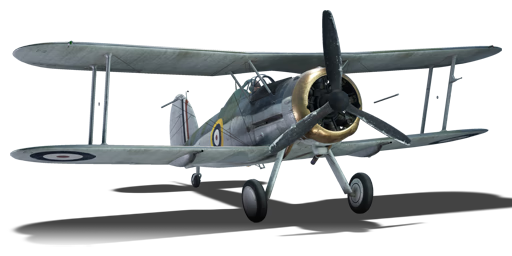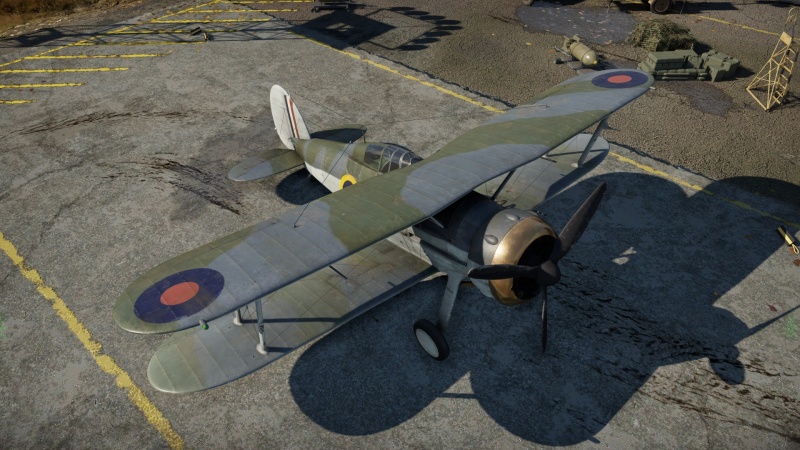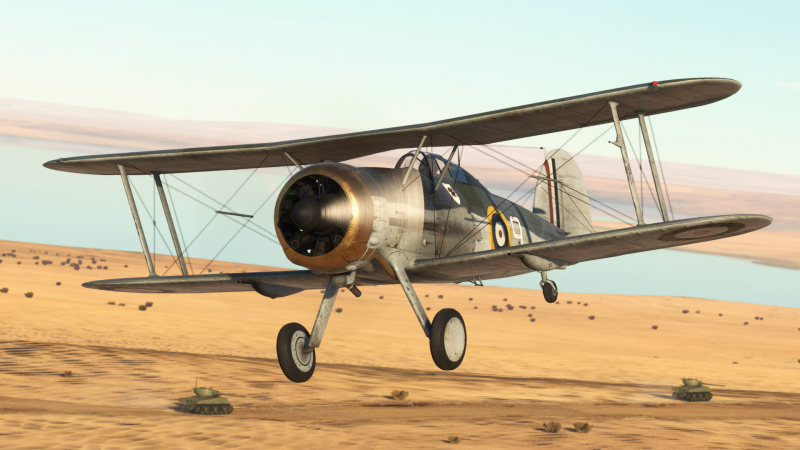Difference between revisions of "Gladiator Mk II"
(Edits) |
U178117757 (talk | contribs) m (→Flight performance: RB stock speed) (Tag: Visual edit) |
||
| Line 43: | Line 43: | ||
|- | |- | ||
! Stock | ! Stock | ||
| − | | 399 || | + | | 399 || 387 || rowspan="2" | {{Specs|ceiling}} || 16.7 || 17.7 || 13.0 || 13.0 || rowspan="2" | 232 |
|- | |- | ||
! Upgraded | ! Upgraded | ||
| Line 210: | Line 210: | ||
;Related development | ;Related development | ||
| + | |||
* [[Gladiator (Family)]] | * [[Gladiator (Family)]] | ||
Revision as of 02:27, 1 September 2024
| This page is about the British fighter Gladiator Mk II. For other versions, see Gladiator (Family). |
Contents
Description
The Gladiator Mk II is a rank British fighter with a battle rating of (AB), (RB), and (SB). It has been in the game since the start of the Open Beta Test prior to Update 1.27.
The Gladiator Mk II is one of the first British tech tree fighters that can be researched (the other two being the Hurricane Mk I/L and the Sea Gladiator Mk I), and once researched leads into the famous Spitfire fighter line.
At rank I with a battle rating of (AB), (RB), and (SB), this plane will typically be one of the first fighters a new player will research. However, the Gladiator, like its sea-based cousin, may be difficult to seek success in, especially in Realistic Battles mode. Within Realistic Battles, when up-tiering comes into play, it will have to deal with not only biplane adversaries such as the CR.42, F3F and the very manoeuvrable Ki-10, but also more advanced fighters such as the P-40E, Bf 109s, I-16s, and Ki-43s. All these plane types have several varying advantages against the Gladiator, which can make early grinding a bit unbearable for some players.
There are a couple of issues with the Gladiator, all of which can make it an easy target at times:
- Its power plant configuration, which includes a three-blade fixed-pitch propeller, can make the Gladiator a slug in acceleration and climb. In-flight testing the Gladiator can usually only sustain at most around 3,000 ft/min (roughly 15 m/s) in a climb at around 180 - 200 km/h (111 - 124 mph) indicated airspeed, and its top speed isn't great either (at sea level it can only manage around 335 km/h, and testing has yielded 396 km/h at 4,000 m altitude).
- The Gladiator manoeuvres well. However, it bleeds a lot of speed in sharp turns, and while its turn radius is good enough to shake off reserve planes, the loss of speed can make the plane a slower and henceforth a more vulnerable target to any other enemy planes in the area. Using flaps does help a bit with decreasing the amount of speed lost in a turn, but it is not beneficial enough to allow for minimal loss of speed. Like most early British fighters, it does not fare well in high-speed dives.
The Gladiator has four 7.7 mm (.303) Browning machine guns with a total of 2,000 rounds on hand. As with most other 7.7 mm guns the default rounds for the Browning's can be a bit weak in stopping power, but when equipped with tracer belts the four guns on this plane can be a deadly force to be reckoned with, as they can trigger fires and do a considerable amount of damage as a result.
General info
Flight performance
The Gladiator Mk II behaves very well in the sky, it got a decent acceleration to compared single set of wings fighters, but for a Biplane it got a excellent acceleration. manoeuvrability like many other Biplanes of War Thunder it's an excellent turnfighter and avoid bursts with, making it a plane to avoid trying to engage with at close combat. For a biplane it got an excellent speed to get close to the other biplanes but can also keep up with other fighter types can have problem with the acceleration to keep up with certain fighters. Its most important characteristics is being able to turn and keep up with other biplanes, being able to handle up to 11G and -5G make it a good plane to make tight turns without having to be concerned about the G force overload.
| Characteristics | Max Speed (km/h at 4,420 m) |
Max altitude (metres) |
Turn time (seconds) |
Rate of climb (metres/second) |
Take-off run (metres) | |||
|---|---|---|---|---|---|---|---|---|
| AB | RB | AB | RB | AB | RB | |||
| Stock | 399 | 387 | 16.7 | 17.7 | 13.0 | 13.0 | 232 | |
| Upgraded | 431 | 414 | 15.3 | 16.0 | 18.8 | 15.7 | ||
Details
| Features | ||||
|---|---|---|---|---|
| Combat flaps | Take-off flaps | Landing flaps | Air brakes | Arrestor gear |
| X | ✓ | ✓ | X | X |
| Limits | ||||||
|---|---|---|---|---|---|---|
| Wings (km/h) | Gear (km/h) | Flaps (km/h) | Max Static G | |||
| Combat | Take-off | Landing | + | - | ||
| N/A | 469 | 320 | ~11 | ~5 | ||
| Optimal velocities (km/h) | |||
|---|---|---|---|
| Ailerons | Rudder | Elevators | Radiator |
| < 240 | < 180 | < 330 | > 190 |
| Compressor (RB/SB) | ||
|---|---|---|
| Setting 1 | ||
| Optimal altitude | 100% Engine power | WEP Engine power |
| 4,100 m | 810 hp | 850 hp |
Survivability and armour
The Gladiator Mk II does not have any particular armour on the plane itself, making the pilot exposed to being hit by bullet can be fatal and instantly knocked unconscious. The survivability of the aircraft over all is decent when in its own BR and not facing any cannons other than most 7,62mm and 7,92mm Machine guns. But it's still best to avoid being hit as much as possible in the Gladiator Mk II since it does not have much armour its survivability can be questioned at the damage it can take before going down.
Modifications and economy
Armaments
Offensive armament
The Gladiator Mk II is armed with:
- 2 x 7.7 mm Browning .303 machine guns, nose-mounted (600 rpg = 1,200 total)
- 2 x 7.7 mm Browning .303 machine guns, wing-mounted (400 rpg = 800 total)
Usage in battles
Simulator:
The Gladiator is a lovely plane to learn with in Sim. It can be used in turnfighting and bomber interception. Like in AB and RB, it is excellent in turning tightly and continuously, and it has lovely low-speed handling and low stall speeds, making it a great starter plane for Sim. Also it has a decent reflector sight for an early biplane, unlike other early planes with those awful telescope-like sight, which is an advantage in all engagements. However it does have its drawbacks: the rather big nose blocks the visibility a lot, offering very poor over-the-nose visibility which is a disadvantage in a turn fight, because when leading a shot the enemy will always get obstructed by the engine, making the player guess the shot. Also its upper wings and various frames and strings between the wings will get in the way when you look aside.
Note: it is recommended to set the convergence within 300 m, with vertical convergence on, because the majority of turnfights happen at that range or closer.
Before engaging a fight, it is better to have an altitude advantage first. When approaching the fight try to figure out which is your teammate and which is the enemy, to avoid going for a second pass, as the energy retention of the Gladiator is rather slow. Also pick your target carefully. For easier aiming, you want to go for those unmanoeuvrable twin engine aircraft like Ju 88 or Ki-45, or bombers if there are any. Given the bad forward visibility of the Gladiator, these are the best options as they are quite slow and sluggish, and are a bigger target to hit. However getting hits on them doesn't mean good damage, so you must be patient. When dealing with fighters, it is way harder to aim. The elevator control of the Gladiator is quite sensitive, giving it good manoeuvrability, but at the same time, bad handling. The Gladiator will respond in a very fast turn upon moving your stick/mouse by a little bit, which makes tracking nimble planes quite hard. But once you get used to it, try to lure every enemy into a turnfight, as that is where the Gladiator shines. Quite a bit of bullets are required to effectively damage the enemy so you must be patient. If you find an enemy at your six, utilise your great turning ability and simply do tight turns, most monoplanes won't be able to cut inside your turn and they might disengage. However with biplanes you will need some defensive manoeuvres like barrel rolls.
If you are not very experienced in Sim, you can also go for even bigger targets (bombers) for easier aiming. However you want to be more careful when hunting bombers, since with the Sim control (whether it be mouse joystick or a real stick) the plane will manoeuvre much more gently, making itself a great target for the bomber's gunners. DO NOT follow behind a bomber's six unless you are sure that its tail gunners are unconscious. Chasing behind a bomber makes yourself stationary for the tail gunners, and you will be showered with bullets. Your big radial engine will usually get damaged. Instead, before attacking, get an altitude advantage over the bomber by flying around 2 km above it. The bomber should only fill up about 1/6 of your gunsight. The best position for an attack is at the bomber's high six so you can adjust the lead much easier. Dive at the bomber, but not directly at it, try to predict where you two will crash by imagining yourself as a missile, that's where you should aim at (deflection shooting). To maximise the damage it is better to aim for their wings and engines, as the fuselage usually soaks up quite some bullets. Only fire when the bomber passes in front of your guns. This short window might seem inadequate to do anything, but with a accurate burst on the engine the 4 MG can at least damage it. With an engine damaged most bombers cannot go far.
Enemies worth noting:
Ki-27, N1K1, He 51, I-15, etc. - Those commonly seen planes are equally good at turnfights and will be a hard target to down since they are very small and agile. To deal with them you need to practice leading and deflection shots, plus manoeuvres like barrel rolls and scissors. They still need plenty of bullets to get damaged, so these kind of targets are the hardest to kill and requires great skills from the player. Specific notes to the I-15: do not try to out-turn it. Use the Gladiator's speed advantage over it.
Do 17 Z-2 - This early twin engine plane always shows up as an AI controlled recon aircraft that you have to down, which is a good news as AI won't manoeuvre aggressively. However this plane is extremely durable for the Gladiator's weak MGs. When it shows up as an AI, deflection shots are not recommended as the small shooting windows really does nothing. Instead, try disabling its 2 gunners first, then just sit behind it and burst on its wings and engines. When attacking the gunners try to not get your engine damaged by pulling evasive manoeuvres as soon as the bullets come close, since the Do 17 might outrun the Gladiator in a level flight if your engine is damaged.
He 100, Bf 109 E, He 112 - These early monoplanes might not be able to out-turn the Gladiator, but they can easily outrun it as the Gladiator is rather slow. These fighters will usually BnZ you, so you must constantly look above and behind you. If they are diving on you, use your roll rate and dodge under their negative G areas. Most players will try to follow up, if not immediately losing track of you. Several dodges might make them impatient and give up BnZ, and if they really start to turnfight with you, they are already dead.
Manual Engine Control
| MEC elements | ||||||
|---|---|---|---|---|---|---|
| Mixer | Pitch | Radiator | Supercharger | Turbocharger | ||
| Oil | Water | Type | ||||
| Controllable | Not controllable Not auto controlled |
Not controllable Not auto controlled |
Not controllable Not auto controlled |
Separate | Not controllable 1 gear |
Not controllable |
Pros and cons
Pros:
- Armament is equal to or better than other fighters in its battle rating range
- Good manoeuvrability in a turn
- Tracer belts, like all other planes fitted with Browning machine guns, can be deadly
- Has flaps, unlike most other biplane fighters
Cons:
- Sluggish in acceleration and top speed (fixed-pitch propeller can exacerbate this problem)
- Performance deficiencies can make it an easy target for experienced or more difficult adversaries
- Not the best climber
- Bleeds speed in turns, even when using flaps
History
One of the greatest claims to fame of the Gloster Gladiator was the Siege of Malta, which was, at the time, controlled by Great Britain. Because of the high value of Malta (it is only about 400 miles south of Italy, and on the map, it is an island in the middle of the Mediterranean), the IAF (Italian Air Force) using mainly SM.79 Sparviero bombers began bombing Malta into submission starting June 11, 1940. Due to the remote location of Malta and the fact that the British forces had to cover the Suez Canal, there were very few fighters available to defend against the IAF - so few that, as legend has it, there were only 3 Gloster Gladiators available: Faith, Hope, and Charity. In reality, there were at least 6 Gladiators, and after the first few weeks of the Siege, 4 Hurricanes en route to North Africa were pressed into service. Amazingly, against 40 - 50 bombers in the initial raids, the resistance was fierce enough to force the Italians to send a fighter escort of MC.200 Saetta fighters. By the end of 1940, Malta was nowhere near defeated, and quite, on the contrary, the RAF claimed an impressive 45 kills. However, the antiquated Gladiators were retired, being replaced by more effective Hurricane IIAs and Spitfires.
| Archive of the in-game description | |
|---|---|
|
The Gloster Gladiator was a single engine, single seat fighter which entered service in 1937 as the Royal Air Force's last biplane fighter. Often overshadowed by more modern monoplanes, it still remained arguably the greatest biplane fighter of all time. Biplane design was already considered outdated by the time production of the Gladiator started, but it was feared that Britain might not have time to develop more modern monoplanes in sufficient quantities before full scale war began. Building on the success of the earlier Gauntlet fighter, the Gladiator was developed to replace the aging Bristol Bulldog. Featuring an enclosed cockpit, new wings and a more streamlined fixed undercarriage, the armament was also increased to four 0.303 inch machine guns. Initially, 231 Gladiator Mk Is were delivered to the RAF. The Mk II model had the more reliable Bristol Mercury VIIIA / AS engine with an output of 830 horsepower in place of the Mk I's Mercury IX; this was also fitted with an electrical starter motor, automatic mixture control, Vokes air filter and a metal three bladed propeller to replace the earlier wooden two bladed variant. 38 Gladiator Mk IIs were also fitted with arrestor hooks to serve in the Fleet Air Arm as Sea Gladiators until 60 fully navalised variants were also delivered, the latter being fitted with catapult points and a dinghy stowage. A total of 746 Gladiator aircraft were produced, and served with distinction in the opening phases of the war, notably during the Norwegian Campaign and in the defence of Malta. Pilots who achieved success in the Gladiator included the RAF's top scorer, Squadron Leader 'Pat' Pattle, who scored 15 ½ confirmed kills in Gladiators, and Royal Navy Commander Charles Keighly-Peach, who trained several of his Swordfish pilots in fighter tactics to operate from HMS Eagle in the Mediterranean. | |
Media
- Skins
- Videos
See also
- Related development
External links
| Gloster Aircraft Company, Limited | |
|---|---|
| Fighters | Gladiator Mk II · Sea Gladiator Mk I · Gladiator Mk IIF · Gladiator Mk IIS · Tuck's Gladiator Mk II |
| Jet Fighters | Meteor F Mk 3 · Sea Meteor F Mk 3 · Meteor F Mk 4 G.41F · Meteor F Mk 4 G.41G · Meteor F Mk 8 G.41K · Meteor F Mk.8 Reaper |
| Javelin F.(A.W.) Mk.9 | |
| Export | J8A · Iacobi's J8A · ␗Gladiator Mk I · ▄Gladiator Mk I |
| ▄Meteor F Mk.8 · Meteor F.8 · Meteor NF.13 | |
| See Also | Fokker |






